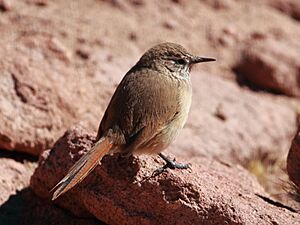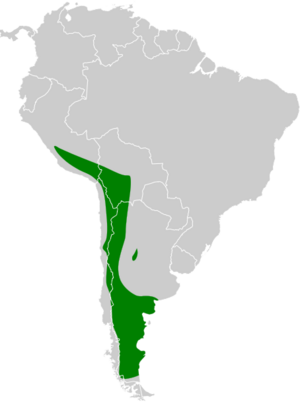Cordilleran canastero facts for kids
Quick facts for kids Cordilleran canastero |
|
|---|---|
 |
|
| at San Pedro de Atacama, Antofagasta Region, Chile | |
| Conservation status | |
| Scientific classification | |
| Genus: |
Asthenes
|
| Species: |
modesta
|
| Subspecies | |
|
See text |
|
 |
|
The Cordilleran canastero (Asthenes modesta) is a small bird that belongs to the ovenbird family. You can find it in Argentina, Bolivia, Chile, and Peru. It's known for living in high, rocky areas.
Contents
About This Bird
The Cordilleran canastero is a small bird, usually about 15 to 16 centimeters (6 inches) long. It weighs between 13 and 22 grams (less than an ounce). Both male and female birds look very similar.
What Does It Look Like?
This bird has a dull dark brown color on its head, back, and rump. It has a light, thin stripe above its eye. Its wings are dark brown with reddish-brown edges. The tail feathers are mostly dark, but the outer ones have more reddish-brown color.
On its throat, it has a pale brownish color with a small orange-red patch in the middle. Its chest and belly are light brown. The legs and feet are dark gray. Young birds don't have the orange-red patch on their throat.
There are several types of Cordilleran canasteros, called subspecies. They look a bit different from each other, for example, some might have darker backs or grayer feathers.
Where It Lives
The Cordilleran canastero lives in the Andes mountains and nearby lowlands. Each subspecies lives in a specific area:
- A. m. proxima: Central and southern Peru.
- A. m. modesta: Southwestern Peru, western Bolivia, northern Chile, and northwestern Argentina.
- A. m. hilereti: Tucumán and Catamarca provinces in northwestern Argentina.
- A. m. rostrata: Eastern Andes in central Bolivia.
- A. m. serrana: La Rioja Province in western Argentina.
- A. m. cordobae: Central Argentina.
- A. m. australis: Central and southern Chile, and western and southern Argentina.
Its Home Environment
This bird likes to live in high grasslands, especially those with rocks and small bushes. It also lives in dry mountain areas with shrubs and open woodlands. You can find it from near sea level up to very high places, about 4,500 meters (14,760 feet) above sea level.
Bird Behavior
Daily Life
The Cordilleran canastero stays in the same area all year round. It doesn't migrate.
What It Eats
This bird eats arthropods, which are creatures like insects and spiders. It usually looks for food alone, but sometimes in pairs. It finds its food mostly on the ground and sometimes on low plants.
Reproduction and Family Life
Cordilleran canasteros usually breed during the spring and summer in the Southern Hemisphere, from October to March. They are believed to stay with one partner.
They build a nest that looks like a cylinder or a ball, using twigs, often thorny ones. Inside, they line the nest with soft feathers and hair. They can place their nests in many different spots, like cracks in rocks, inside bushes, in holes in dirt banks, or even in old nests built by other birds. A female bird usually lays two to four eggs. We don't know how long the eggs take to hatch or when the young birds leave the nest.
Bird Calls and Songs
The song of the Cordilleran canastero is a fast trill that goes up in pitch and then stops suddenly. It also makes a more complex trill with some notes at the beginning. Its calls are short, low sounds like "pyup" or "tjit."
Conservation Status
The IUCN (International Union for Conservation of Nature) says the Cordilleran canastero is a species of "Least Concern." This means it's not currently in danger of disappearing. It lives across a very large area, and while its population size isn't fully known, it's thought to be decreasing. There are no major threats identified right now. This bird is quite common in many parts of its range. However, the places where it lives are often affected by animals grazing too much.


